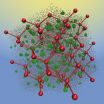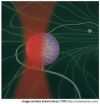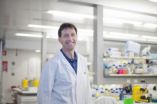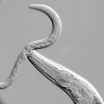Study of cancer cell metabolism yields new insights on leukemia
2013-01-17
(Press-News.org) University of Rochester Medical Center scientists have proposed a new reason why acute myeloid leukemia, one of the most aggressive cancers, is so difficult to cure: a subset of cells that drive the disease appear to have a much slower metabolism than most other tumors cells.
The slower metabolism protects leukemia cells in many important ways and allows them to survive better – but the team also found an experimental drug tailored to this unique metabolic status and has begun testing its ability to attack the disease, URMC researchers report in the Jan. 17, 2013, online edition of Cell Stem Cell.
As a result, the study's corresponding author, Craig T. Jordan, Ph.D., is working on forming a partnership with a drug-maker to conduct further testing in this arena. The compound under laboratory study has already been used in clinical trials.
"Targeting metabolism of leukemia stem cells is a unique approach that we believe has the potential to be broadly applied to several forms of leukemia," said Jordan, the Philip and Marilyn Wehrheim Professor at the James P. Wilmot Cancer Center at URMC. "An exciting part of our work is that because we've identified drugs that are being developed for clinical use, we hope there is significant potential to improve the care of leukemia patients relatively soon."
Lead investigator Eleni Lagadinou, M.D., Ph.D., a post-doctoral fellow in Jordan's laboratory, said that when the team discovered that the metabolism of leukemia stem cells was so different from the rest of the tumor cells, they focused their efforts on exactly how that process works.
They found that leukemia stem cells generate all the energy they need in a cellular powerhouse called the mitochondrion, by way of a single process, known as oxidative phosphorylation. In contrast, other cancer cells and normal stem cells also rely on a second fuel source, known as glycolysis, to generate energy.
With this new information, researchers then explored the pathways involved in oxidative phophorylation, with an eye toward finding an Achilles' heel to stop the process. They discovered that an important gene, BCL-2, is elevated and central to leukemia stem cell energy production.
The team also knew that drugs to inhibit BCL-2 are in various stages of development in the pharmaceutical industry; Lagadinou and Jordan found two such compounds and tested them in human leukemia specimens. Their findings showed the drugs preferentially killed inactive and metabolically slower leukemia stem cells.
Leukemia is known for its ability to lie dormant for long periods, despite treatment, but then suddenly begin another assault.
"This treatment shows promise toward a dormant leukemic stem cell subpopulation that is relatively untouched by conventional drugs," Lagadinou said. "It's also important to note that normal cells were not harmed by the compounds, because they can use alternative pathways to generate energy."
Without the toxicity to healthy cells, researchers hope they can target the disease during periods of remission, when mopping up residual leukemia is essential.
Leukemia is a blood cancer with four common types: acute myelogenous leukemia (AML), acute lymphoblastic (ALL), chronic myeloid leukemia (CML), and chronic lymphoblastic (CLL). AML is most common in adults and the most difficult to treat, in part because it affects immature cells. Nearly 50,000 new cases are diagnosed each year, with about half resulting in death.
Investigators have learned during the past decade that many therapies were not designed to kill the root of leukemia, the so called "leukemia stem cells," and therefore never truly eliminate the disease.
In fact, even the most modern cancer treatments were developed under the assumption that all cancer metabolism relies on glycolysis as a fuel source. This makes the URMC study – and the discovery that oxidative phosphorylation is the single fuel source for leukemia stem cells – all the more relevant for suggesting new and improved treatments, Jordan said.
He is a national leader in the investigation of leukemia stem cells and the search for currently available drugs that selectively target them.
###
Grants from the Leukemia and Lymphoma Society, National Institutes of Health, and New York State Stem Cell Science funded the current study. END
ELSE PRESS RELEASES FROM THIS DATE:
Bacteria's hidden skill could pave way for stem cell treatments
2013-01-17
A discovery about the way in which bugs spread throughout the body could help to develop stem cell treatments.
Researchers at the University of Edinburgh have found that bacteria are able to change the make-up of supporting cells within the nerve system, called Schwann cells, so that they take on the properties of stem cells.
Because stem cells can develop into any of the different cell types in the body – including liver and brain cells – mimicking this process could aid research into a range of degenerative conditions.
Scientists made the discovery studying ...
RUB researchers find over active enzyme in failing hearts
2013-01-17
A certain enzyme, the CaM kinase II, keeps the cardiac muscle flexible. By transferring phosphate groups to the giant protein titin, it relaxes the muscle cells. This is reported by researchers led by Prof. Dr. Wolfgang Linke of the Institute of Physiology at the Ruhr Universität in the journal Circulation Research. In failing hearts, which don't pump enough blood around the body, the scientists found an overly active CaM kinase II. "The phosphorylation of titin could be a new starting point for the treatment of heart failure" Prof. Linke speculates.
Titin phosphorylation ...
Soft Lego built in the computer
2013-01-17
In developing these novel self-assembling materials, postdoc Barbara Capone has focused on the design of organic and inorganic building blocks, which are robust and can be produced at large scale. Capone has put forward, together with her colleagues at the Universities of Vienna and Mainz, a completely new pathway for the construction of building blocks at the nanoscale.
"Soft Lego" orders in crystal structures
The team of researchers has shown that so-called block copolymer stars – that means polymers that consist of two different blocks and they are chemically ...
Vaginal delivery is the safest option for women with pelvic girdle pain
2013-01-17
Caesarean section increases the risk of persistent pelvic girdle pain after delivery compared with vaginal delivery, according to a new study from the Norwegian Institute of Public Health.
Caesarean section rates are increasing worldwide, and this trend has partly been explained by women's requests for planned caesarean section without a medical reason. Pregnancy-related pelvic girdle pain has been associated with increased preference for caesarean section and with increased planned caesarean section rates.
"Some women with severe pelvic girdle pain might fear that ...
A nano-gear in a nano-motor inside you
2013-01-17
To live is to move. You strike to swat that irritable mosquito, which skilfully evades the hand of death. How did that happen? Who moved your hand, and what saved the mosquito? Enter the Molecular Motors, nanoscale protein-machines in the muscles of your hand and wings of the mosquito. You need these motors to swat mosquitoes, blink your eyes, walk, eat, drink... just name it. Millions of motors tug as a team within your muscles, and you swat the mosquito. This is teamwork at its exquisite best.
Paradoxically, a weak and inefficient motor (called dynein) is the one that ...
A hidden treasure in the Large Magellanic Cloud
2013-01-17
Nearly 200 000 light-years from Earth, the Large Magellanic Cloud, a satellite galaxy of the Milky Way, floats in space, in a long and slow dance around our galaxy. Vast clouds of gas within it slowly collapse to form new stars. In turn, these light up the gas clouds in a riot of colours, visible in this image from the NASA/ESA Hubble Space Telescope.
The Large Magellanic Cloud (LMC) is ablaze with star-forming regions. From the Tarantula Nebula, the brightest stellar nursery in our cosmic neighbourhood, to LHA 120-N 11, part of which is featured in this Hubble image, ...
Potential new treatment for gastrointestinal cancers discovered
2013-01-17
Researchers have identified a complex of proteins that promotes the growth of some types of colon and gastric cancers, and shown that medications that block the function of this complex have the potential to be developed into a new treatment for these diseases.
The complex of proteins, known as mTorc1 (mammalian target of rapamycin complex 1), has previously been implicated in the development of some other cancers but this is the first time it has been shown to promote the growth of colon and gastric cancers that are associated with inflammation.
Dr Stefan Thiem and ...
Amputations among people with diabetes can be reduced by 50 percent
2013-01-17
Every 30 seconds somebody in the world is amputated as a consequence of foot complication due to diabetes. A new study at Sahlgrenska Academy, University of Gothenburg, Sweden, confirmes that shoe inserts, podiatry, regular checkups and other simple interventions can reduce the number of amputations by more than 50%.
Orthotic researchers at Sahlgrenska Academy, University of Gothenburg, have studied diabetic foot complications ever since 2008. They have focused on protecting the foot from overloading the foot sole in order to minimize the risk of ulcers, which may eventually ...
The neurobiological consequence of predating or grazing
2013-01-17
This press release is available in German.
Researchers in the group of Ralf Sommer at the Max Planck Institute for Developmental Biology in Tuebingen, Germany, have for the first time been able to identify neuronal correlates of behaviour by comparing maps of synaptic connectivity, or "connectomes", between two species with different behaviour. They compared the pharyngeal nervous systems of two nematodes, the bacterial feeding Caenorhabditis elegans and the predator/omnivore Pristionchus pacificus and found large differences in how the neurons are "wired" together.
A ...
Study offers new insights into the mechanics of muscle fatigue
2013-01-17
A study in The Journal of General Physiology examines the consequences of muscle activity with surprising results, indicating that the extracellular accumulation of potassium that occurs in working muscles is considerably higher than previously thought.
Muscle excitation involves the influx of sodium ions and efflux of potassium ions. Although the fraction of ions that cross the muscle membrane with each contraction is minute, repeated activity can lead to substantial changes in the intracellular and extracellular concentrations of sodium and potassium ions. The extent ...




